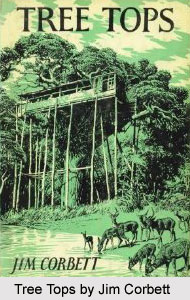 The name clearly depicts the story or the content of the story. Jim Corbett`s has a style of naming the story in a simple manner. And this is also not an exception. Tree Tops clearly says that the story is about the forest and about the treetop that is situated there at the jungle.
The name clearly depicts the story or the content of the story. Jim Corbett`s has a style of naming the story in a simple manner. And this is also not an exception. Tree Tops clearly says that the story is about the forest and about the treetop that is situated there at the jungle.
Edward James `Jim` Corbett was born on July 25th, 1875. The place was, Kumaon, in the beautiful paradise at the foothills of Himalayas. His father Christopher Corbett was postmaster of the town Nainital. From his childhood only he was very much attracted to wild life and consequently he spent his childhood in an area surrounded by beautiful Jungles and dangerous predators. He fell in love with the forest and its animals and since an early age he knew how to mimic animal sounds and track lethal predators. The quality of his even saved his life in many cases. He is also known as a conservationist and a big game photographer. Jim Corbett is actually famous as the hunter of the man-eaters. But on principle he never killed any innocent animal. Until it becomes troublesome for the people he never attacked any animal. He resorted largely to removing those dangerous Man-Eaters that terrorized Indian villagers a century ago. All the villagers used to take help from Corbett very often. At that time people would rather die of starvation in their huts than venture out in the open where the tigers growled and cunning leopards lay in waiting. But Corbett was fearless and tried to make the jungle a safe place for the people as well.
Synopsis:
`Tree tops` is a story written by Jim Corbett, which is based on a real treetop. Now this is called as tree top hotel. The treetop was built to accommodate 100 visitors near to a big water body where the wild animals including tiger, buffaloes, and elephants come to quench their thrust. One can see other such as waterbuck and bushbuck and an occasional bongo in the evening. In this book the description of treetop is given in a nice way that anyone can feel it in front of his or her eyes. The balcony is at least 30 feet above the pool, and from here anyone can see the remains of the old Tree Tops on the other side. It was burned down by the mau mau in 1954. It was built on a giant ficus tree and accommodated five or six people one time. In this place in the month of February, 1952 princess Elizabeth arrived with her husband to spend the night, and Corbett was invited to join them. They finished their dinner and fag and at that time one news came that king George VI has passed away in his sleep in Sandringham. This made the princess next heir to the throne. So it is described in the book very interestingly that one day one girl climbed in to a tree as a princess and surprisingly she climbed down as a Queen. And this happened for the first time. Corbett finished writing the final manuscript of this book on 6 April 1955. 13 days later he was dead. The book was published in October that year with an excellent foreword by Lord Hailey. He was Jim Corbett`s dear friend who helped him immensely in the creation of India`s first National park while he was the governor of U. P. The Corbett Park is India`s permanent tribute to the man who truly loved, respected and helped the poor of India.
Tree Tops is available in paperback in India, published by Oxford. This is the last creation of Jim Corbett.
Tree Top is last creation of Jim Corbett. This is the only story, which is set outside India. Corbett set the backdrop at the savage beauty of Kenya`s wildlife. He also narrates the royal visit in 1952 during which princess Elizabeth became queen Elizabeth.



















